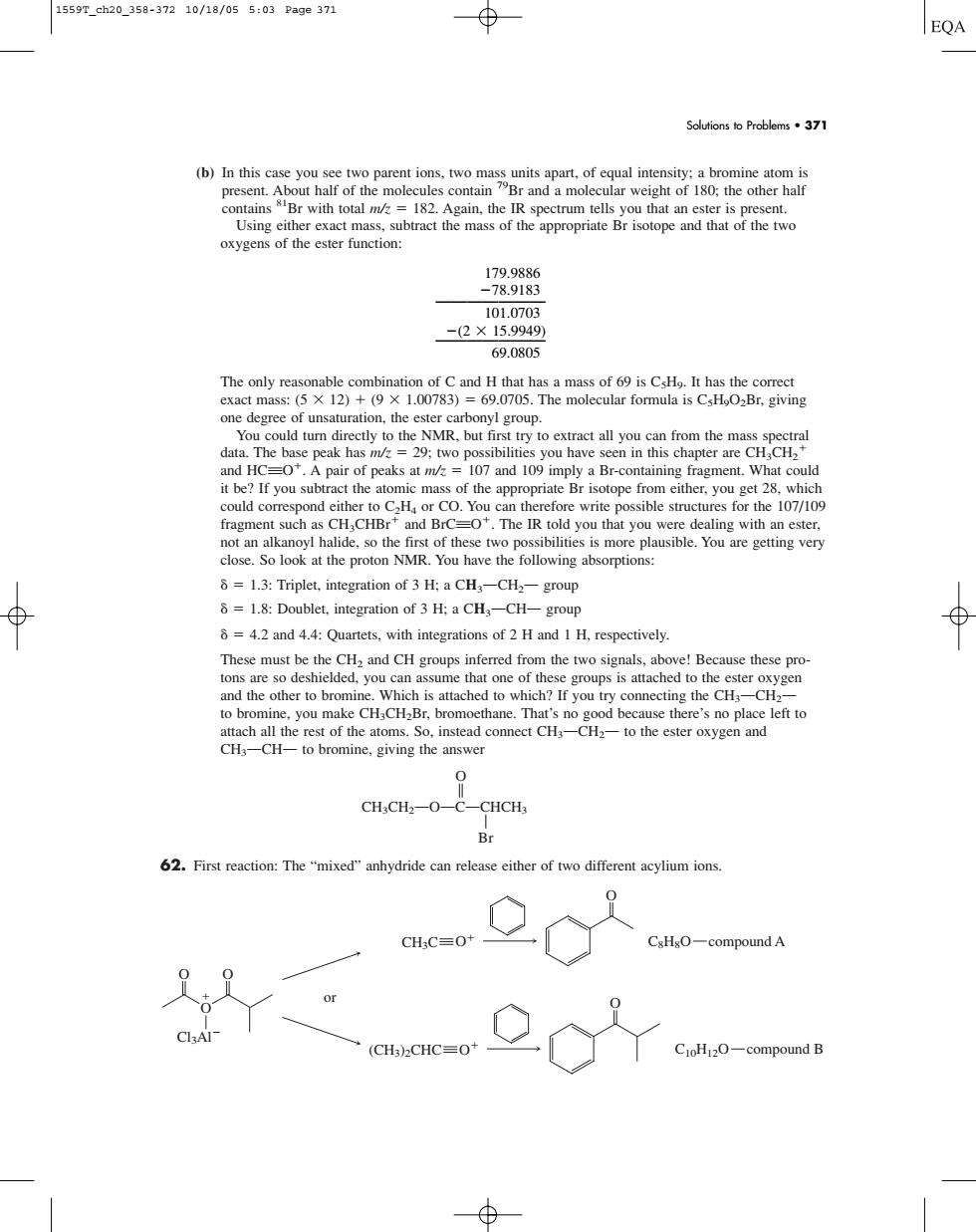正在加载图片...

1559T_ch20_358-37210/18/055:03Page371 ⊕ EQA Solutions to Problems.371 contains】 e。 oxygens of the ester function: 179.9886 -78.918 69.080 and HC=O.A pair of peaks atm/107 and 109 imply a Br-containing fragment.What could fragment such as CH,CHBr and BrC=O.The IR told you that you were =1.3:Triplet.integration of 3 H:a CH3-CHa-group =1.8:Doublet,integration of 3 H:a CH-CH-group 4.2and4.:Quartets.with integrations of Hand H.respectively. These must be the CHa and CH groups inferred from the two signals,above!Because these pro- CCr hre Th -to the ester oxygen and 0 CH;CHz-O-C-CHCHs Br 62.First reaction:The"mixed"anhydride can release either of two different acylium ions CH:C=0 CsHsO-compound A (CH:)CHC=0+ C1oH2O-compound B (b) In this case you see two parent ions, two mass units apart, of equal intensity; a bromine atom is present. About half of the molecules contain 79Br and a molecular weight of 180; the other half contains 81Br with total m/z 182. Again, the IR spectrum tells you that an ester is present. Using either exact mass, subtract the mass of the appropriate Br isotope and that of the two oxygens of the ester function: The only reasonable combination of C and H that has a mass of 69 is C5H9. It has the correct exact mass: (5 12) (9 1.00783) 69.0705. The molecular formula is C5H9O2Br, giving one degree of unsaturation, the ester carbonyl group. You could turn directly to the NMR, but first try to extract all you can from the mass spectral data. The base peak has m/z 29; two possibilities you have seen in this chapter are CH3CH2 and HCqO. A pair of peaks at m/z 107 and 109 imply a Br-containing fragment. What could it be? If you subtract the atomic mass of the appropriate Br isotope from either, you get 28, which could correspond either to C2H4 or CO. You can therefore write possible structures for the 107/109 fragment such as CH3CHBr and BrCqO. The IR told you that you were dealing with an ester, not an alkanoyl halide, so the first of these two possibilities is more plausible. You are getting very close. So look at the proton NMR. You have the following absorptions: 1.3: Triplet, integration of 3 H; a CH3OCH2O group 1.8: Doublet, integration of 3 H; a CH3OCHO group 4.2 and 4.4: Quartets, with integrations of 2 H and 1 H, respectively. These must be the CH2 and CH groups inferred from the two signals, above! Because these protons are so deshielded, you can assume that one of these groups is attached to the ester oxygen and the other to bromine. Which is attached to which? If you try connecting the CH3OCH2O to bromine, you make CH3CH2Br, bromoethane. That’s no good because there’s no place left to attach all the rest of the atoms. So, instead connect CH3OCH2O to the ester oxygen and CH3OCHO to bromine, giving the answer O B CH3CH2OOOCOCHCH3 A Br 62. First reaction: The “mixed” anhydride can release either of two different acylium ions. CH3C C8H8O compound A O O or (CH3)2CHC C10H12O compound B O Cl3Al O O O O 179.9886 78.9183 101.0703 (2 15.9949) 69.0805 Solutions to Problems • 371 1559T_ch20_358-372 10/18/05 5:03 Page 371���������������